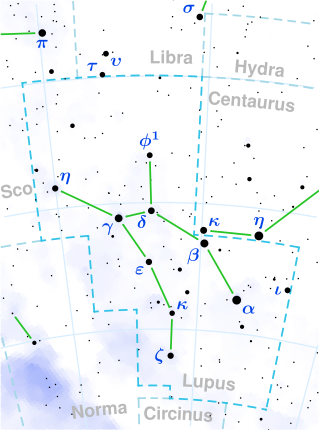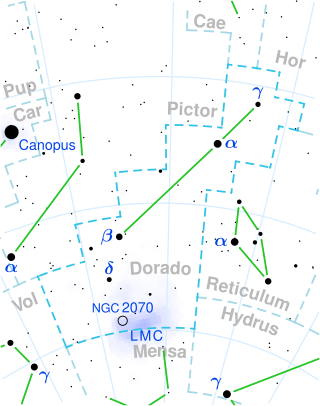
ν Virginis, Latinized as Nu Virginis, is a single star in the zodiac constellation of Virgo, located at the western tip of the classic constellation and nearly due south of the prominent star Denebola. It is a red-hued star with an apparent visual magnitude of 4.04 and can be seen with the naked eye. Because the star lies near the ecliptic it is subject to occultations by the Moon. Parallax measurements provide an estimated distance of around 331 light years from the Sun, and it is drifting further away with a radial velocity of +50 km/s.

Psi Virginis is a suspected binary star system in the zodiac constellation of Virgo. It can be seen with the naked eye and has an apparent visual magnitude of about 4.8. Based upon the annual parallax shift of 5.99 milliarcseconds, the distance to this star is roughly 540 light years. The angular size of Psi Virginis was measured on December 26, 1975 during an occultation by the Moon, yielding the estimate 6.5±0.3 mas.

Sigma Virginis is a star in the zodiac constellation of Virgo. It can be faintly seen with the naked eye with a baseline apparent visual magnitude of 4.86. Based upon parallax measurements, the distance to this star is roughly 680 light-years.

Omega Virginis is a solitary star in the zodiac constellation Virgo. It has an apparent visual magnitude of +5.2, which is bright enough to be faintly visible to the naked eye. Based upon an annual stellar parallax shift of 6.56 milliarcseconds, it is located about 500 light years from the Sun.

28 Andromedae is a Delta Scuti variable star in the constellation Andromeda. 28 Andromedae is the Flamsteed designation. It also bears the variable star name GN Andromedae. Its apparent magnitude is 5.214, varying by less than 0.1 magnitudes.

54 Arietis is a star in the northern zodiac constellation of Aries. 54 Arietis is the Flamsteed designation. It is a challenge to view with the naked eye even under good viewing conditions, having an apparent visual magnitude of 6.27. Based upon an annual parallax shift of 4.39 mas, it is located approximately 740 light-years distant from Earth, and it is drifting further away with a radial velocity of +44 km/s. The brightness of the star is diminished by 0.15 in magnitude from extinction caused by interstellar gas and dust. The star is positioned near the ecliptic and thus is subject to lunar occultations.

2 Centauri is a single star in the southern constellation of Centaurus, located approximately 183 light-years from Earth. It has the Bayer designation g Centauri; 2 Centauri is the Flamsteed designation. This object is visible to the naked eye as faint, red-hued star with an apparent visual magnitude of 4.19. It is moving away from the Earth with a heliocentric radial velocity of +41 km/s. The star is a member of the HR 1614 supercluster.

HD 128333 or CH Boötis is an irregular variable star in the northern constellation of Boötes. It is currently on the asymptotic giant branch of the HR diagram.
HD 30442 is a solitary star in the northern circumpolar constellation Camelopardalis. It is faintly visible to the naked eye with an apparent magnitude of 5.47 and is estimated to be 403 light years away from the Solar System. The object has a heliocentric radial velocity of −37 km/s, indicating that it is drifting closer.

Gamma Reticuli is a solitary star in the southern constellation of Reticulum. With an apparent visual magnitude of 4.5, it can be faintly seen with the naked eye. Based upon an annual parallax shift of 6.95 mas, it is located roughly 469 light years from the Sun. At that distance, the visual magnitude is diminished by an extinction factor of 0.08 due to interstellar dust.

54 Eridani is a suspected astrometric binary star system located around 400 light years from the Sun in the equatorial constellation of Eridanus. It is visible to the naked eye as a faint, reddish hued star with a baseline apparent visual magnitude of 4.32. The object is moving closer to the Earth with a heliocentric radial velocity of −33 km/s.
Phi2 Hydrae, Latinized from φ2 Hydrae, is a star in the constellation Hydra. It originally received the Flamsteed designation of 1 Crateris before being placed in the Hydra constellation. Based upon an annual parallax shift of 4.31 mas as seen from Earth, it is located roughly 760 light years from the Sun. The star is faintly visible to the naked with an apparent visual magnitude of 6.09. It forms a triangle with the fainter φ1 Hydrae and the brighter φ3 Hydrae, between μ Hydrae and ν Hydrae.
Pi Leonis, Latinised from π Leonis, is a single star in the zodiac constellation Leo. It is a red-hued star that is visible to the naked eye with an apparent visual magnitude of 4.70. This object is located at a distance of some 410 light-years from the Sun based on parallax, and is drifting further away with a radial velocity of +22 km/s. Because the star lies near the ecliptic it is subject to occultations by the Moon.

Phi1 Lupi is a solitary star in the southern constellation of Lupus. It is visible to the naked eye with an apparent visual magnitude of 3.58. Based upon an annual parallax shift of 11.86 mas as seen from Earth, it is located around 275 light years from the Sun. The star is drifting closer with a radial velocity of −29 km/s. It has an absolute magnitude of −1.55.

28 Monocerotis is a single star in the equatorial constellation of Monoceros. It has an orange-hue and is faintly visible to the naked eye with an apparent visual magnitude of 4.69. The distance to this star is approximately 450 light years based on parallax, and it has an absolute magnitude of −1.00. The star is drifting further away from the Sun with a radial velocity of +26.7 km/s.
90 Tauri is a star in the zodiac constellation of Taurus, located 144 light-years away from the Sun. It is visible to the naked eye as a faint, white-hued star with an apparent visual magnitude of 4.27. 90 Tauri is a member of the Hyades cluster and is listed as a double star.
DU Lyncis is a single variable star in the constellation Lynx. It is a faint star but visible to the naked eye with an apparent visual magnitude of 5.15. With an annual parallax shift of 9.2 mas, it is located some 350 light years from the Sun. The star is moving closer with a heliocentric radial velocity of −37 km/s.
HD 46815 is a solitary star in the southern constellation Columba. It is faintly visible to the naked eye with an apparent magnitude of 5.4 and is estimated to be 408 light years away. However, it is receding with a heliocentric radial velocity of 32.2 km/s.

8 Leonis Minoris is a solitary, red hued star located in the northern constellation Leo Minor. It has an apparent magnitude 5.37, making it faintly visible to the naked eye. Based on parallax measurements from the Gaia satellite, the object is estimated to be 492 light years distant. It is receding with a heliocentric radial velocity of 40 km/s. At its current distance, 8 LMi is diminshed by 0.12 magnitudes due to interstellar dust.

WZ Doradus is a solitary red-hued variable star located in the southern constellation Dorado. It has an average apparent magnitude of 5.21, making it faintly visible to the naked eye under ideal conditions. Gaia DR3 parallax measurements imply a distance of 580 light-years and it is currently receding with a heliocentric radial velocity of 19.3 km/s. At its current distance, WZ Doradus is diminished by two-tenths of a magnitude due to interstellar extinction and it has an absolute magnitude of −1.00.











